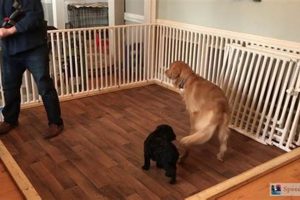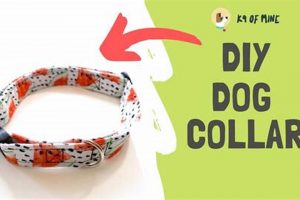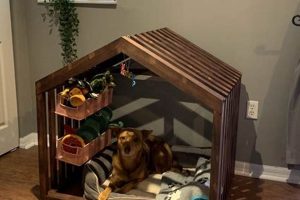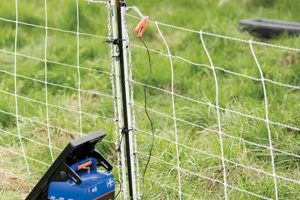A self-regulating pet food dispenser, often constructed from repurposed materials, ensures a continuous supply of kibble for canines. Its functionality relies on gravity to replenish the food bowl as it empties, providing a hands-free feeding solution. Examples range from simple inverted bottle designs to more elaborate setups using plastic containers and PVC piping.
Such devices offer several advantages, including convenience for pet owners with busy schedules and the potential to regulate food intake for dogs prone to overeating. Historically, simplified versions have been used in agricultural settings to automatically provide feed to livestock, demonstrating a long-standing need for automated feeding systems. The ability to prepare a sufficient quantity of food for one or multiple days will allow the keeper to rest easy.
The subsequent sections will address the various construction methods, material selection criteria, and potential drawbacks associated with creating an automated food dispensing system for dogs. Further consideration will be given to hygiene and maintenance protocols. Food safety considerations will also be reviewed.
Construction and Usage Guidelines
The following guidelines aim to assist in the successful creation and deployment of an automated canine feeding apparatus, ensuring the animal’s health and safety.
Tip 1: Material Selection is Crucial. Opt for food-grade plastics or stainless steel components to minimize the risk of chemical leaching and bacterial contamination. Porous materials should be avoided.
Tip 2: Design for Easy Cleaning. Incorporate features that facilitate regular cleaning, such as wide openings and removable parts. Bacteria can thrive in enclosed, damp spaces.
Tip 3: Monitor Food Flow. Observe the rate at which kibble dispenses. Adjust the design to prevent overfilling or blockages, which could lead to starvation or digestive upset.
Tip 4: Secure the Structure. Ensure the feeder is stable and cannot be easily tipped over by the dog. Accidental spills can create unsanitary conditions and attract pests.
Tip 5: Introduce Gradually. Allow the dog to acclimate to the new feeding device slowly. Immediate reliance may cause anxiety or rejection.
Tip 6: Consider Dog Size and Breed. Tailor the dimensions of the feeder to the dog’s size to prevent neck strain or difficulty accessing the food.
Tip 7: Supervise Initial Use. Closely monitor the dog’s interaction with the feeder during the first few days. This allows for early detection of any potential problems or unsafe behaviors.
Adherence to these recommendations promotes the safe and effective use of the automated feeding system, contributing to the well-being of the canine companion.
The final section will summarize the important factors for safety in constructing and using the canine feeding system.
1. Food-grade materials
The selection of appropriate materials is paramount in the construction of a gravity-operated feeding apparatus for canines. The proximity of the material to the food intended for animal consumption necessitates careful consideration of its composition and potential for leaching contaminants.
- Minimizing Chemical Leaching
Food-grade plastics, such as high-density polyethylene (HDPE) or polypropylene (PP), are formulated to minimize the transfer of chemicals into the food they contact. Non-food-grade plastics may contain phthalates, bisphenol A (BPA), or other substances that can migrate into the kibble over time, potentially posing health risks to the animal. The use of verified food-grade materials is a proactive measure to mitigate exposure to potentially harmful substances.
- Preventing Bacterial Contamination
Smooth, non-porous surfaces associated with food-grade materials inhibit bacterial growth and facilitate thorough cleaning. Rough or porous materials can harbor bacteria, increasing the risk of foodborne illness. Stainless steel is an example of a non-porous food-grade material that is suitable to use. Regular cleaning with appropriate food-safe disinfectants is essential, but the inherent properties of food-grade materials contribute significantly to maintaining a hygienic feeding environment.
- Ensuring Regulatory Compliance
Food-grade materials adhere to specific regulatory standards established by organizations such as the Food and Drug Administration (FDA). Compliance with these standards ensures that the materials have undergone testing and are deemed safe for repeated contact with food. Verifying that the chosen materials meet these standards provides an additional layer of assurance regarding their suitability for use in a canine feeding device.
- Extending Food Shelf Life
Some food-grade materials possess properties that can help prolong the shelf life of the kibble stored within the feeder. For example, opaque materials can protect the food from light exposure, which can degrade certain nutrients. Airtight seals, when incorporated into the design, can minimize oxidation and maintain food freshness for a longer duration. While not the primary function, these properties provide an added benefit in maintaining food quality.
The integration of food-grade materials into the automated feeding apparatus is not merely a design consideration but a fundamental aspect of responsible pet ownership. By prioritizing the use of these materials, one actively contributes to the long-term health and well-being of the canine companion, mitigating potential risks associated with chemical contamination and bacterial growth.
2. Stable structure
Structural integrity is paramount when constructing a gravity-based food dispenser for canines. A stable structure prevents accidental tipping, food spillage, and potential injury to the animal. The design must withstand the dog’s interaction with the feeder, including nudging, leaning, or accidental collisions.
- Base Support and Weight Distribution
A wide, weighted base is crucial for stability. The center of gravity should be low to the ground to resist tipping. Examples include using a heavy ceramic bowl as the base or adding weights to the bottom of a plastic container. Uneven weight distribution can lead to instability, increasing the likelihood of spills.
- Material Strength and Durability
The materials used must be strong enough to support the weight of the food reservoir. Weak materials can buckle or break, causing the structure to collapse. For instance, thin-walled plastic containers are susceptible to cracking, whereas thicker, more rigid materials like PVC piping or sturdy metal can provide greater support. Consider material’s resistance to weather. Sunlight can cause some plastic materials to warp.
- Joint Security and Fastening Methods
All connections between components must be securely fastened to prevent separation. This includes using strong adhesives, screws, or bolts, depending on the materials. Improperly secured joints can weaken over time, leading to structural failure. Proper joint security will make the device stronger and safer for both owner and dog.
- Design Geometry and Load Bearing
The overall shape of the feeder should distribute weight evenly and minimize stress points. Tall, slender designs are more prone to tipping than shorter, wider ones. Triangular supports or reinforced corners can enhance load-bearing capacity. Design considerations should account for static load of kibble and dynamic load from animal interaction. Properly plan a design that fits the needs of the owner and animal.
The interplay between these structural elements directly influences the functionality and longevity of the feeding apparatus. A well-designed, stable unit provides a safe and reliable feeding solution, while a poorly constructed one can pose risks to the animal and require frequent repairs or replacements. Prioritizing stability is a key aspect of responsible design and construction.
3. Controlled dispensing
In the context of a self-constructed gravity-based canine feeding system, controlled dispensing refers to the mechanism’s ability to release kibble at a predictable and manageable rate. A primary concern is preventing overfeeding, a condition linked to canine obesity and related health complications. Without controlled dispensing, a free-flowing system may deliver excessive quantities of food, negating the convenience and potentially harming the animal. For example, a system using a wide-mouthed bottle inverted over a bowl may continuously release food, leading to unrestricted access and potential overconsumption. Conversely, a system employing a narrow opening and a shallow dish may limit the dispensing rate, providing a measured amount of food over a longer period.
The design of the dispensing mechanism directly influences the effectiveness of control. A simple baffle or flow restrictor placed within the dispensing channel can regulate the release of kibble, creating a back-pressure and reducing the flow rate. Alternative designs may incorporate adjustable openings, allowing the user to fine-tune the dispensing rate based on the dog’s individual needs and activity level. The physical characteristics of the kibble itself, such as size and shape, can also affect dispensing rates. Systems should be tested and calibrated to ensure consistent and predictable food delivery regardless of kibble variation.
Achieving effective controlled dispensing in a self-constructed system presents inherent challenges. Inconsistencies in material dimensions, variations in kibble size, and the lack of precise manufacturing tolerances can all impact performance. However, understanding the principles of flow regulation and implementing simple design modifications can significantly improve dispensing control. This enhanced control contributes to responsible pet ownership, promoting a healthy diet and preventing overfeeding in canine companions. This enhances the utility of such systems for canine owners.
4. Hygienic design
Hygienic design is a critical element in the construction of a self-made gravity-operated canine feeding system. The close and prolonged contact between food and the apparatus creates an environment conducive to bacterial growth and contamination. Prioritizing hygienic design mitigates these risks, safeguarding the animal’s health and ensuring food safety.
- Material Selection for Cleanability
The choice of construction materials directly influences the ease and effectiveness of cleaning. Non-porous materials, such as stainless steel or food-grade plastics like high-density polyethylene (HDPE), resist bacterial adhesion and facilitate thorough sanitation. Conversely, porous materials like unfinished wood can harbor bacteria, making them unsuitable for use in a feeding apparatus.
- Accessibility for Cleaning
A design that allows for easy disassembly and access to all interior surfaces is essential for effective cleaning. Complex geometries with tight corners or inaccessible crevices can trap food particles and promote bacterial growth. Designing the system with removable components and wide openings simplifies the cleaning process and ensures that all surfaces can be adequately sanitized. Use brushes for tight spots.
- Prevention of Moisture Accumulation
Moisture creates an ideal environment for bacterial proliferation. Designs should incorporate features that minimize moisture accumulation, such as adequate ventilation and drainage. Inclined surfaces can prevent water from pooling, while strategically placed air vents can promote drying. Proper design can prevent moisture accumulation. The accumulation of moisture can be reduced with proper planning.
- Regular Maintenance Protocols
Even with a well-designed system, regular cleaning is paramount. Establishing a consistent maintenance schedule involving thorough washing with a food-safe disinfectant is crucial. Disassembly, inspection for damage or wear, and complete drying are important steps in preventing bacterial contamination and ensuring the long-term hygienic performance of the feeding apparatus. Regular cleaning can prevent build-up of bacteria in certain areas.
Integrating these facets of hygienic design into the construction and maintenance of a gravity-based canine feeding system minimizes the risk of bacterial contamination and promotes food safety. The extra care and planning invested in the early stages will result in long-term health benefits for the animal and peace of mind for the owner.
5. Proper sizing
The dimensioning of a self-constructed gravity-fed food dispenser for canines significantly impacts the animal’s ability to access food comfortably and safely. The feeder’s height, bowl diameter, and dispensing rate must be appropriately scaled to the dog’s size, breed, and physical capabilities. For example, a feeder that is too tall may force the dog to strain its neck excessively while eating, potentially leading to musculoskeletal problems over time. Conversely, a feeder that is too low may require the dog to crouch uncomfortably, hindering proper digestion.
The diameter of the food bowl must be sufficient to accommodate the dog’s muzzle and prevent food spillage. An undersized bowl can lead to frustration and inefficient feeding, while an oversized bowl may encourage overeating. The dispensing rate must also be considered, ensuring that the feeder delivers an adequate amount of food without overwhelming the dog or creating a mess. Smaller breeds, in particular, benefit from feeders designed to dispense kibble in smaller portions, preventing bolting of food and promoting healthy digestion. A common example would be matching the size and height with the breed and height of the animal for use with a doberman as opposed to a miniature poodle.
In summary, proper sizing is a non-negotiable element in the design and construction of a canine feeding device. Failure to adequately consider the animal’s physical characteristics and feeding habits can negate the benefits of automation and potentially compromise its health and well-being. Careful consideration of these factors contributes directly to the overall efficacy and safety of the self-constructed feeding system, promoting responsible pet ownership.
6. Smooth flow
The consistent and unimpeded movement of kibble within a gravity-based canine feeding system is essential for reliable operation. Disrupted or irregular flow can lead to empty bowls, food blockages, and ultimately, an inconsistent feeding schedule for the animal. Smooth flow, therefore, is a vital design consideration.
- Gravity Angle and Hopper Design
The angle of the hopper walls and the shape of the dispensing opening significantly influence the flow rate. Steep angles promote consistent downward movement, while shallow angles may cause kibble to bridge or become lodged. A funnel-shaped hopper with a gradually narrowing outlet is generally more effective than a cylindrical design. The optimal angle and shape depend on the kibble’s size, shape, and texture. For instance, larger kibble may require a wider opening to prevent blockages.
- Surface Friction and Material Selection
The material used for the hopper and dispensing channel should minimize friction. Smooth surfaces like polished plastic or stainless steel allow kibble to slide easily, whereas rough surfaces impede flow. Static electricity can also cause kibble to cling to the sides of the hopper, disrupting the flow. Anti-static coatings or materials can help mitigate this issue. For example, some plastics can generate static electricity, causing kibble to clump and preventing proper dispensing.
- Kibble Size and Shape Uniformity
Variations in kibble size and shape can impact flow consistency. Uniform kibble tends to flow more smoothly than a mixture of different sizes and shapes. Dust and small particles generated from kibble breakage can also accumulate and clog the dispensing mechanism. Regular cleaning of the hopper and dispensing channel is necessary to remove debris and maintain optimal flow. Consider using a sifting device to remove dust and small particles prior to filling the feeder. For example, round kibble tends to flow better than irregular shaped kibble. This should be considered for the construction of an ideal diy gravity dog feeder.
- Dispensing Aperture and Anti-Bridging Mechanisms
The size and shape of the dispensing aperture play a crucial role in controlling the flow rate. A sufficiently large opening is needed to prevent blockages, but too large an opening can lead to uncontrolled dispensing. Anti-bridging mechanisms, such as agitators or internal baffles, can help prevent kibble from becoming compacted or forming arches within the hopper. Some designs incorporate a rotating paddle or vibrating plate to promote consistent flow, an example of which is an internal agitator or baffle to promote consistent flow.
These facets of smooth flow are interconnected. Optimizing one aspect without considering the others can result in suboptimal performance. A well-designed gravity-based canine feeding system addresses all these factors to ensure a consistent and reliable food supply, promoting the health and well-being of the animal.
7. Gradual introduction
The implementation of a self-constructed gravity-based feeding system for canines necessitates a measured acclimation process. Abrupt transitions to automated feeding can induce stress and behavioral changes in the animal, potentially negating the system’s intended benefits. Gradual introduction mitigates these risks, promoting acceptance and ensuring a positive feeding experience.
- Familiarization with the Apparatus
Prior to introducing the automated system, the animal should be allowed to interact with the feeder in a non-feeding context. Placing the empty feeder in the dog’s environment allows it to investigate the new object without associating it with a change in feeding routine. Positive reinforcement, such as treats or praise, can further encourage exploration and reduce anxiety. For example, a dog hesitant to approach the feeder may gradually become more comfortable with its presence through repeated exposure and positive interactions.
- Transitional Feeding Methodology
A phased approach to integrating the feeder into the dog’s feeding schedule can facilitate acceptance. Initially, the feeder can be used to supplement the existing feeding method. Gradually increasing the proportion of food dispensed by the automated system while simultaneously reducing the amount provided in the traditional bowl allows the dog to adjust to the new feeding mechanism. This transitional approach minimizes disruption to the animal’s established routine. Owners should observe their pets behavior to ensure they are adapting.
- Monitoring Behavioral Cues
Close observation of the dog’s behavior during the introduction phase is crucial for identifying signs of stress or discomfort. Changes in appetite, increased anxiety, or avoidance of the feeder may indicate a need to slow the transition or modify the system’s design. Adjustments to the feeder’s height, dispensing rate, or food bowl material may alleviate these issues. Addressing negative behavioral cues promptly can prevent the development of aversion towards the feeder. Some dogs may show signs of distress such as increased barking or hiding.
- Reinforcing Positive Associations
Positive reinforcement techniques can be employed to create a positive association with the automated feeding system. Providing treats or praise when the dog approaches or eats from the feeder can encourage acceptance and reduce anxiety. This approach reinforces the idea that the feeder is a source of positive experiences. Consistency in reinforcement is essential for establishing a strong positive association. Owners should avoid negative reinforcement. Owners can use positive reinforcement when introducing the device.
By employing a gradual introduction strategy, owners can maximize the likelihood of successful integration of a self-constructed gravity-based feeding system into the canine’s routine. This approach prioritizes the animal’s well-being, mitigating stress and promoting a positive feeding experience. Observation and patience on behalf of the owner are key to a successful transition, ensuring long-term acceptance and utility of the automated feeding system.
Frequently Asked Questions
The following addresses common inquiries regarding the design, construction, and implementation of self-made gravity-based feeding systems for domestic canines.
Question 1: What materials are safe for constructing a gravity-fed dog feeder? Food-grade plastics, such as high-density polyethylene (HDPE) and polypropylene (PP), and stainless steel are generally considered safe. These materials minimize chemical leaching and resist bacterial growth. Avoid porous materials like untreated wood, as they can harbor bacteria.
Question 2: How often should a gravity-fed dog feeder be cleaned? A gravity-fed dog feeder should be cleaned at least once a week, or more frequently if visible debris or residue is present. Disassemble the feeder and wash all components with a food-safe detergent and hot water. Ensure thorough drying before reassembling and refilling.
Question 3: How do I prevent my dog from overeating with a gravity feeder? The dispensing rate of the feeder should be controlled to prevent overeating. Select a feeder with an adjustable dispensing mechanism or modify the design to restrict the flow of food. Measure the appropriate daily food portion for the dog and monitor the amount dispensed by the feeder.
Question 4: Can a gravity feeder be used for wet or raw food? Gravity feeders are generally not suitable for wet or raw food due to the increased risk of bacterial contamination and spoilage. These types of food require more frequent cleaning and temperature control to maintain safety.
Question 5: How do I introduce a gravity feeder to my dog? Gradual introduction is recommended. Place the empty feeder near the dog’s existing food bowl, allowing it to investigate the new object. Gradually transition by filling the feeder with increasing amounts of food while reducing the amount in the traditional bowl. Monitor the dog’s behavior for signs of stress or anxiety.
Question 6: What are the potential drawbacks of using a gravity feeder? Potential drawbacks include the risk of overeating, the need for regular cleaning to prevent bacterial contamination, and the potential for the feeder to malfunction or become blocked. Careful design, monitoring, and maintenance are essential to mitigate these risks.
Proper material selection, regular cleaning, and controlled dispensing are critical to the safe and effective use of gravity-based canine feeding systems.
The following section will address potential modifications and customizations that enhance the functionality and safety of these systems.
diy gravity dog feeder
This discourse explored the multifaceted aspects of “diy gravity dog feeder” construction, emphasizing crucial elements such as material safety, structural stability, controlled dispensing, hygienic design, appropriate sizing, smooth flow, and gradual introduction. Successful implementation necessitates careful consideration of each factor to ensure the well-being and safety of the canine.
The creation of a self-regulating feeding mechanism for a canine companion requires a commitment to both functionality and responsible pet ownership. The information presented serves as a foundation for informed decision-making, urging a meticulous approach to design and implementation. The long-term health of the animal rests upon the diligence and forethought invested in this endeavor.







